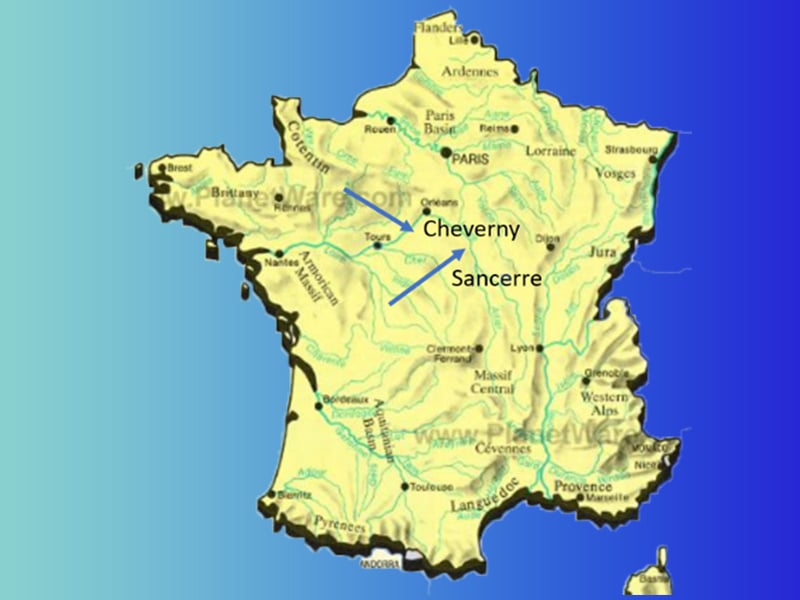Take a trip to Sancerre
- Posted on
- Posted in france, Sauvignon Blanc
- 0

Take a trip to Sancerre, which is in the Centre région of the Lorie Valley, the center of France for one of your wines. It is coming to the height of summer, and the weather is finally heating up. A high acid, medium body, food friendly wine, with a little chill on it, would be perfect for June! After all, the farmer’s markets are bringing in those raspberries, strawberries, rhubarb, crisp lettuce, and melons. All of which will sit well next to your glass of Pinot Noir. (You thought I was going to say Sauvignon Blanc! Got ya!). Pinot Noir out dates Sauvignon Blanc in Sancerre. Why Sauvignon Blanc is better represented now? Come in and ask, there are more stories to share with you. But on to summer and white wine this weekend!
You white wine lovers will still be thrilled with June. The other wine this month is from the little village of Cheverny, which is also part of the Lorie Valley, in the sub region of Touraine. This one has 85% Sauvignon Blanc and 15% is Chardonnay. So, for those of you excited for a refreshing Sauvignon Blanc, this will not disappoint. My husband even liked it! And that is HUGE considering his crazy taste buds. A story, which if you want to hear it, can be told when next you come in. But I digress, let us focus on the weird and the exploratory. This is what I love about Wine Cru and I am grateful you wish to explore with me!
Where is Sancerre? The Armoricain Massif mountains are to the west, the Massif Central mountains to the south, the Vosges, Ardennes, and Rhineland mountains to the east. It is really in the center of France. I mention the placement of the mountains because they influence weather and climate, and the mountains are the outline the Paris Basin that occupies nearly 25% of France. The wind starts inland from the northern English Channel area, flows through the Paris Basin dropping moisture onto France’s main agriculture area. Sancerre’s climate would be drier if not for this moisture. The wind collects on the south western side of the basin, and then dry wind accelerates through the Rhone Valley and out to the Mediterranean. The basin was nicknamed the Granary of France. The basin mainly grows cereals and civilization, but you also find Champagne and Chablis in this basin as well.
The bigger part of Sancerre’s climate is caused by the Lorie River, which is on the southern part of the basin. The Lorie Valley is broken into four distinct regions, with the commonalty of the Lorie River. This river runs from East to West toward the Atlantic Ocean. Sancerre experiences a continental climate as it is so far inland. A continental climate is described as very cold winters, very hot summers, and little rain fall. Sancerre receives mitigation from the extremes of continental climate (sort of) due to the presence of the Lorie River, which brings rain to the region. The rainfall, however, can come at inopportune times. Spring frosts that threaten flowering and summer hailstorms that threaten fruit growth. The river forces air circulation, which helps to mitigate some of those threats. Growers that plant their vineyards on the steep slopes also help with the climate issues. Southern facing slopes, at that latitude, experience a longer light during the day and thus have a longer growing season. The combination of low light intensity (lower sun angle) and low heat (because of the elevation) makes for restrained flavors in the final wine product. Many of the growers pursue sustainable farming techniques. Organic farming is not possible in some places because of the humidity and its propensity for making diseased grapes. Another vineyard production note, the growers in Sancerre purposely reduce their yield by pruning while the grapes are still green (dropping some of the unripe fruit) to help the remaining fruits increase in flavor intensity.
The third part that makes the region such a quality wine producing place is the soil. The roots of the vines dig into Kimmeridgian Limestone, which is composed of calcium carbonate from skeletal fragment of corals and shellfish. This may sound familiar, because as you know, the Kimmeridgian Limestone extends from not so far away Chablis and parts of Champagne. On top of this layer could be one of three different types of soil (or a slight mix); Cillottes - which contributes to aromatics, Terre Blanches - which contributes to slow ripening, creating structure and ability, and Silex -which contributes a flinty, mineral, and sometimes a smokey note.
Check out City Vino’s selections for further investigation!
Alphones Mellot la Moussiere Sancerre France 2020
Regis Minet Vieilles Vignes Pouilly Fume Loire France 2020
Sager and Verdier Sancerre France 2020

Comments
Be the first to comment...